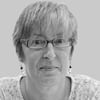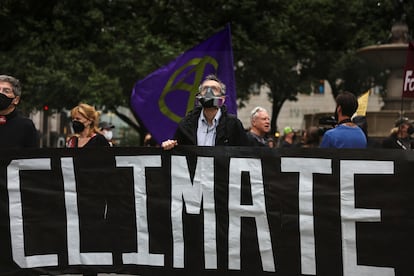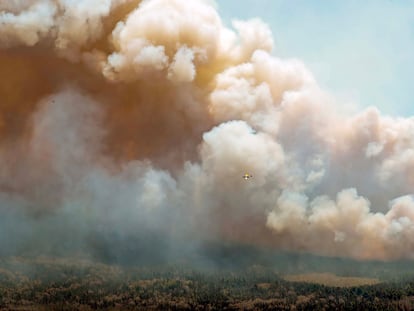How wildfires made New York’s air unbreathable: ‘It’s like being at a barbecue, engulfed in smoke’
Although air quality began to improve on Friday, the effects of the devastating blazes in neighboring Canada prompted authorities to hand out a million free face masks while flights and outdoor activities were canceled


Masks are back in New York. The city that gave up the face mask long before the Covid-19 pandemic receded is once again using them, but this time against the smoke from Canada’s record-breaking series of wildfires. Unlike during the pandemic, the mask is being used outdoors, while enclosed spaces have become a refuge, except for the subway, which has become more polluted than ever. The use of masks has been recommended by the authorities along with advice against going outdoors if it can be avoided. Warnings were sent via cell phones for the third consecutive day on June 8, stating that the air quality index (AQI) has risen to “very harmful.”
Air quality began improving on Friday, but was still below healthy levels. “Smoke from Canadian wildfires continues to be transported south by winds into the U.S. resulting in moderate to unhealthy air quality across parts of the Northeast, Mid-Atlantic, Ohio Valley, and Midwest on Friday. Some improvement is expected this weekend,” said the National Weather Service in a tweet.
June 8 also saw the authorities distribute one million N95-type masks free of charge — 400,000 in the main transportation hubs, state parks and the Javits Center, a multipurpose pavilion that hosts fairs and conventions, and the rest among the state’s local administrations. But the masks were already ubiquitous on the city’s streets the previous day to mitigate the acrid sting of smoke and the intense smell of burning. On June 7, the air quality level marked an average of 342 in the city, more than double that of New Delhi (164), and with higher peaks in Queens and the Bronx, where 413 was recorded.

“I must have bought them at the drugstore,” says Rose, an athletic 60-year-old. “I hadn’t used them for over a year. But I had to take the dog out. My husband won’t even dare to go out until the emergency is over. He is asthmatic and therefore at risk. If it gets too bad, we’ll ask a dog walker to take care of the dog while this lasts, but I hear they’re in high demand.”
Hanging over the city is a rain of visible dust and soot particles, plus microscopic ones, such as PM2.5, capable of penetrating the lungs and reaching the bloodstream. The smoke has tinged the sky orange, although a timid sun bleached the horizon on the morning of June 8. Even the leafy Central Park did not afford citizens a breather.
So apocalyptic has the threat been that the city has set up a toll-free hotline to provide information on the evolution of the emergency. The alert was originally scheduled to last until midnight on June 7, but was extended for almost 24 hours, and then for another full day, until June 9. Several baseball games were suspended, including the Yankees’ game, while some zoos in the northern part of the State closed their doors and prepared to evacuate the most vulnerable species to indoor facilities, starting with birds. Planes bound for LaGuardia Airport were grounded due to zero visibility and children spent recess in classrooms on June 7 before the schools closed altogether. Broadway shows and free activities in several city parks, which are generally abuzz in June, were suspended. Even runners were invited to take the day off, despite June 7 being Global Running Day. However, a few diehard individuals jogged bare-faced through Central Park early June 8.
Teleworking among those whose jobs lend themselves to it, such as Google workers, has been the order of the day, though delivery drivers and laborers have been forced to remain on the streets. “This is like being at a barbecue, you’re engulfed in smoke,” explained a worker at a construction site in the Bronx on June 7, where the air was even more threateningly dense than in Manhattan. Gustavo Ajche, a deliveryman who works in the financial district, acknowledged a day later that pedaling with a mask on leaves him exhausted, but that it is even worse without one. “My eyes itch, I am continuously clearing my throat and have had a persistent headache since this started. But we can’t stop; it’s like during the pandemic, people keep asking for food.”

‘Canada is burning and New York hogs the spotlight?’
An AQI peak of 218 at 10 p.m. on June 6 triggered the emergency. According to the air quality index, between 101 and 150 is considered unhealthy for vulnerable groups, including asthmatics, coronary patients, infants and the elderly; from 151 to 200, it’s unhealthy for everyone; from 201 to 300 very unhealthy and from 301, dangerous. It is hard to imagine an eight-hour day on the job with a value of 413 like the one recorded on June 7 in the Bronx, the worst since the Environmental Protection Agency (EPA) began taking measurements in 1999. Normally, the city scores below 50, which is considered good. Between 2017 and 2022, New York never featured on the list of the 3,000 cities with the worst air quality in the world.
“I had been smelling smoke since I came home from work on Tuesday and thought someone had lit the fire, which seemed absurd in the heat,” says Diana Kass, who lives north of Manhattan. “As the smell lingered, I searched the internet and saw the news of the Canadian fires. Anyone who doesn’t want to see a direct link to climate change is either blind or foolish. Or votes for Trump,” she adds, referring to the former president’s climate denialism, even though no research has yet linked Canada’s wave of wildfires to climate change, nor the cloud of smoke and ash in the northeastern United States.

The impact of the Canadian spate of fires on New York’s air quality had already manifested itself in modest intermittent peaks throughout May, when the index rose to 75, but the fires have ramped up in intensity this month and the viralization of the ghostly images has flagged up the vulnerability of any city to sudden climatic crises. “Canada has been burning for weeks and New York hogs the spotlight? How do you explain it?” Kass asks.
Sign up for our weekly newsletter to get more English-language news coverage from EL PAÍS USA Edition
Tu suscripción se está usando en otro dispositivo
¿Quieres añadir otro usuario a tu suscripción?
Si continúas leyendo en este dispositivo, no se podrá leer en el otro.
FlechaTu suscripción se está usando en otro dispositivo y solo puedes acceder a EL PAÍS desde un dispositivo a la vez.
Si quieres compartir tu cuenta, cambia tu suscripción a la modalidad Premium, así podrás añadir otro usuario. Cada uno accederá con su propia cuenta de email, lo que os permitirá personalizar vuestra experiencia en EL PAÍS.
¿Tienes una suscripción de empresa? Accede aquí para contratar más cuentas.
En el caso de no saber quién está usando tu cuenta, te recomendamos cambiar tu contraseña aquí.
Si decides continuar compartiendo tu cuenta, este mensaje se mostrará en tu dispositivo y en el de la otra persona que está usando tu cuenta de forma indefinida, afectando a tu experiencia de lectura. Puedes consultar aquí los términos y condiciones de la suscripción digital.
More information
Archived In
Últimas noticias
Most viewed
- Sinaloa Cartel war is taking its toll on Los Chapitos
- Oona Chaplin: ‘I told James Cameron that I was living in a treehouse and starting a permaculture project with a friend’
- Reinhard Genzel, Nobel laureate in physics: ‘One-minute videos will never give you the truth’
- Why the price of coffee has skyrocketed: from Brazilian plantations to specialty coffee houses
- Silver prices are going crazy: This is what’s fueling the rally










































